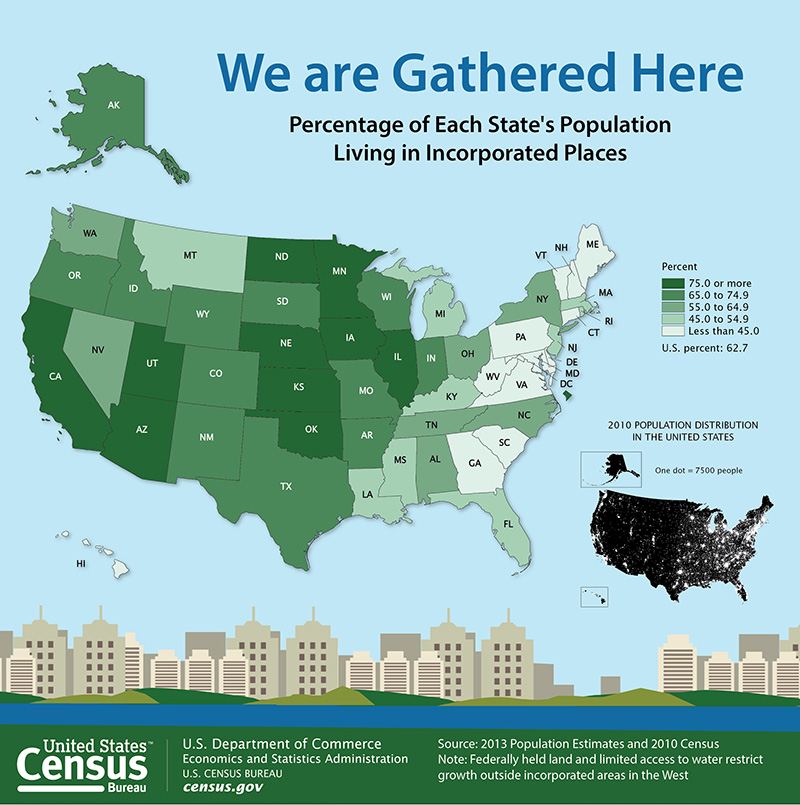U.S. Cities Contain 62.7% of the Population, but Comprise Only 3.5% of Land Area
A majority of the U.S. population lives in incorporated places or cities.
A majority of the U.S. population lives in incorporated places or cities, although these areas only make up a small fraction of the U.S. land area, according to a report released March 4 by the U.S. Census Bureau.
The percentage of the population living in cities in 2013 was highest in the Midwest and West at 71.2 percent and 76.4 percent, respectively.
“The higher percentage of people living in cities in the West can partly be explained by the limited access to water outside of western cities and federally held land surrounding many of these cities, which limits growth outside incorporated areas,” said Darryl Cohen, a Census Bureau analyst and the report’s author. “This is especially true in Utah, where 88.4 percent of the population lives in an incorporated place.”
The report, “Population Trends in Incorporated Places: 2000 to 2013,” draws from population estimates data on more than 19,000 cities across the U.S., including trends in population growth and loss, population density, geographic distribution, annexation and new incorporations.
The population density in cities is more than 46 times higher than the territory outside of cities. The average population density for cities is 1,593.5 people per square mile, while the density outside of this area is only 34.6 people per square mile. Population density generally increases with city population size. The population density of cities with 1 million or more people is 7,192.3 people per square mile.
Additional findings included:
- Cities with the largest land area are mostly in the West and have fewer people per square mile. Four places in Alaska are among the nation’s largest in land area, such as Sitka city and borough, which consists of 2,870.4 square miles of land and has 3.1 people per square mile.
- Among large cities, density levels increased the most for those with strong population growth and stable boundaries. Population density increased by over 700 people per square mile in both New York City and Washington, D.C., between 2010 and 2013, the highest increases in density among cities of 100,000 or more population.
- Population decline or increases in land area caused decreases in population density in other places.
- Detroit, Mich., and Rockford, Ill., lost 180.7 and 130.9 people per square mile, respectively, between 2010 and 2013.
- Modesto, Calif., and Spokane, Wash., both increased in population size but decreased in density because of annexation of land area.
Annexation
Expansion of municipal boundaries by annexation is uncommon in cities in the Northeast, but it is common practice in the South and West. Between 2010 and 2013:
- Caliente, Nev. (150 miles north of Las Vegas) had the largest land area increase. It acquired 55.7 square miles.
- Kirkland, Wash. (a suburb of Seattle) nearly doubled its population when it increased its boundaries to include 31,796 more people.
- Zionsville, Ind. (a suburb of Indianapolis) annexed territory that was among the largest in both land area and population. Zionsville added 9,159 people and 39.5 square miles of land.
New Incorporated Places
- Between 2010 and 2013, there were 17 new incorporations reported to the Census Bureau. Collectively, these new cities had a 2013 population of 307,191.
- New cities’ populations ranged from about 200 in Sandy Point, Texas, to almost 100,000 in Jurupa Valley, Calif.
- Eight new cities were created in the South (three in Texas alone), four in the West, four in the Midwest and one in the Northeast.
QuickFacts Beta
Find population statistics with improved QuickFacts for all incorporated places. As a result of customer feedback, the tool now includes the ability to compare six geographies at once; access to multiple ways to view the data, including charts and maps; and the ability to share, embed and download content.
NOTE: This press release was submitted to Urban Milwaukee and was not written by an Urban Milwaukee writer. It has not been verified for its accuracy or completeness.
Mentioned in This Press Release
Recent Press Releases by U.S. Census Bureau
Census Bureau Announces Job Openings for 2020 Census
Oct 16th, 2018 by U.S. Census BureauThe 2020 Census Jobs website is now accepting applications for Recruiting Assistants in Milwaukee metropolitan areas and surrounding counties.

















